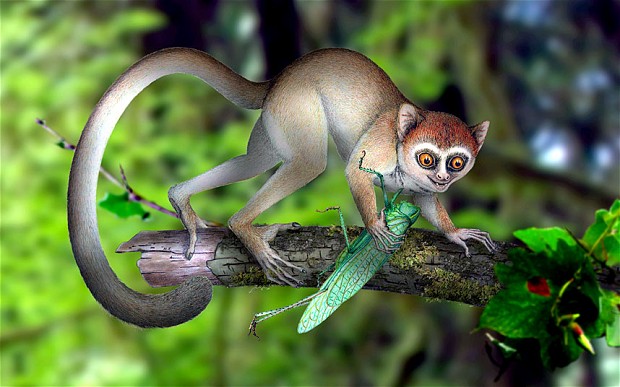Humanity's Lemur-Like Asian Ancestry
Anthropology moves a little toward the revelation.
The purpose of the Urantia papers was theologic revelation. Any scientific statements in the papers are supposedly limited to then-current knowledge, or to things which we cannot discover ourselves. Where the papers' scientific statements seem to differ from currently-popular theory among our scientists, some students of the revelation hold that the papers can be wrong, include errors, which science will "correct," while others believe that, even though no new scientific information was supposed to be revealed, nevertheless, the scientific statements in the papers would be fact, with which our scientific exploration has simply not yet correlated.
Anthropology is a soft science. Human development theory cannot be built up in a truly scientific experimental fashion; rather, our racial progress knowledge is based on whatever tiny fragments of evidence we are lucky enough to stumble upon, what random Nature has permitted by chance to be discovered. One cannot re-run an experiment in fossils, only try to find more to substantiate or refute theory. This inherently gap-plagued pattern of evidence lends itself to broad theoretical speculation. Further, soft scientists are more likely to fall into the traps of favored theories and finding substantiating evidence because you look for it.
♦
Modern fashion has focused on the development of humanoids in Africa, which does not comport with the Urantia papers in practically any way, other than that the ancestry in Africa can be regarded as just one of many lines of human development. The various-colored "Sangik" races first appeared "500,000 years ago [in] the Badonan tribes of the northwestern highlands of India." (UP65 §5 ¶1) The Andonites of a million years ago "did not penetrate very far into Asia, and they did not at first enter Africa."(UP63 §5 ¶1). The popularized supposed African ancestor Lucy was in Ethiopia about 3.2 million years ago. The Urantia papers are not specific, but by five million years ago, the ancestor of humans had not yet appeared, (UP61 §4 ¶7) and it was not until "about one million years ago [that] the immediate ancestors of mankind made their appearance by three successive and sudden mutations stemming from early stock of the lemur type of placental mammal." (UP62 §0 ¶1)
While these early lemurs evolved in the Western Hemisphere, the establishment of the direct mammalian ancestry of mankind took place in southwestern Asia.
Which brings us to this report from June 5 by Richard Gray, Science Correspondent, in The Telegraph (UK).
The mouse-sized fossil, which was discovered in China, is the earliest known cousin of humans yet to be found.
Scientists believe the creature, which has been named Archicebus achilles, provides new insights into where our ancestors first evolved.
Rather than evolving in Africa as was believed in the past, the discovery supports theories that the common ancestor of monkeys, apes and humans first appeared in Asia.
Researchers say Archicebus belongs on a branch of the primate evolutionary tree that eventually evolved into tarsiers, small mammals with big round eyes that live in Asia.
The fossilised skeleton, however, has some features – like a characteristic heel bone – that are still found in our closest animal relatives today.
…
Dr. Chris Beard, one of the team who has been studying the fossil at the Carnegie Museum of Natural History in Pittsburgh, Pennsylvania, said… "The evidence that early primate evolution was restricted to Asia is becoming more compelling by the day." … Dr Beard believes that our early primate ancestors began developing in Asia before moving to Africa around 35 million years ago.
The Urantia papers say that 30,000,000 years ago, "in western North America… the early ancestors of the ancient lemurs first made their appearance."
(The further back one goes, the greater the apparent disparity between science and the UB; one of the two — revelators or scientists — is off in the calculation of time.)
Was this Asian-Lemur ancestry known when the Urantia papers were indicted in the mid-1930s? Is this another "lucky guess" like the papers' support of the then-minor theory of continental drift? I don't have any idea. Do you?
I am strictly a self-taught, arm-chair scientist, and anthropology is a field which I've not been closely following, so I'm not sure how "new" this news is. And I'm open to correction to my facts and understandings.
Email to urantiana@mindfulwebworks.com may be published in whole or part.
Emails to webworker@mindfulwebworks.com will not be published.
Similarly-themed Mindful Urantiana Webworks:
Scientific Evidence of Space Respiration
First People in the Americas
Anthropology & The Urantia Book on hominid evolution



